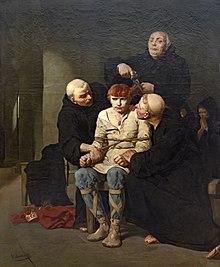Childeric III.
Childeric III. (* around 720–737; † around 755) was the last Merovingian king (743 to 751). It is not known whether he was the son of Chilperic II or Theuderic IV .
After Chilperich II's attempt to regain greater freedom of action had failed around 720, the Merovingian dynasty was de facto disempowered. After Theuderich IV's death in 737, the Carolingian caretaker Karl Martell , who wielded true power in the Frankish Empire, interned Childerich temporarily in the Sithiu monastery (later Saint-Bertin Abbey ) and left the Frankish throne temporarily vacant. Only when Karl Martell's son Karlmann needed a shadow king from the Merovingian family in the spring of 743, Childerich was released and enthroned. The reasons for this are not entirely clear: On the one hand, legality as a necessary prerequisite for royal rule may have caused this recourse to the legendary, albeit probably already insignificant gender, for the last time. On the other hand, there was probably fierce resistance from the other nobles against the power of the house men. In addition, a decisive war against the Bavarian Duke was imminent that year , which the greats of the empire with a rightful king at the head were more willing to wage.
The otherwise almost unknown king only achieved fame through his deposition as the last ruler of his family, which was symbolized by the loss of his long hair. The long hair was a status symbol of the Merovingians, who probably stuck to late antique traditions: In the 5th / 6th centuries. In the 19th century, many warriors wore shoulder-length hair; this was part of the typical appearance of a warlike aristocrat, whether Roman or barbarian. The Merovingian reges could simply have adhered to this increasingly antiquated custom to the end. Such a hairstyle is shown in a highly schematic way on the seal of Childerich I (around 480): The face is beardless; the full long hair, parted in the middle, carefully combed down in strong, simple strands, covers the ears and ends in heavy balls of curls, above which the strands are tied several times.
With the loss of hair came the loss of honor and thus the royal dignity: Childerich III. was publicly sheared and had to enter the same Sithiu Monastery where he had been detained years earlier between October 31, 751 and February 23, 752. His wife Gisela came to the Kochel monastery . Pippin was the first Carolingian to put on the royal crown, and after that one hears nothing more from the Merovingians.
Childeric III. left a son who was not sent to the Sithiu monastery but to the Saint-Wandrille monastery . Otherwise only the name Theuderich (Theoderich) is known of him.
literature
- Pierre Riché : The Carolingians. One family makes Europe . Deutscher Taschenbuch Verlag, Munich 1991, ISBN 3-423-04559-0 .
- Rudolf Schieffer : The Carolingians . Kohlhammer, Stuttgart et al. 1992, ISBN 3-17-010759-3 ( Kohlhammer-Urban-Taschenbücher 441).
- Reinhard Schneider : Election and elevation of the king in the early Middle Ages. Investigations into the succession of power among the Longobards and Merovingians . Hirsemann, Stuttgart 1972, ISBN 3-7772-7203-5 ( Monographs on the History of the Middle Ages 3), (At the same time: Berlin, Freie Univ., Habil.-Schr., 1970/71).
- Richard Delbrück: Spätantike Germanenbildnisse in: Bonner Jahrbücher 149 (1949), pp. 66–81
Individual evidence
- ↑ See for example Maximilianhabenberger: Hair, Sacrality and Symbolic Capital in the Frankish Kingdoms. In: Helmut Reimitz et al. (Ed.): The Construction of Communities in the Early Middle Ages. Leiden 2003, pp. 173-212.
| predecessor | Office | successor |
|---|---|---|
| Theuderic IV. (Interregnum) |
King of the Franks 743–751 |
Pippin the Younger (Hausmeier) |
| personal data | |
|---|---|
| SURNAME | Childeric III. |
| BRIEF DESCRIPTION | last Merovingian king |
| DATE OF BIRTH | at 720 |
| DATE OF DEATH | at 755 |
